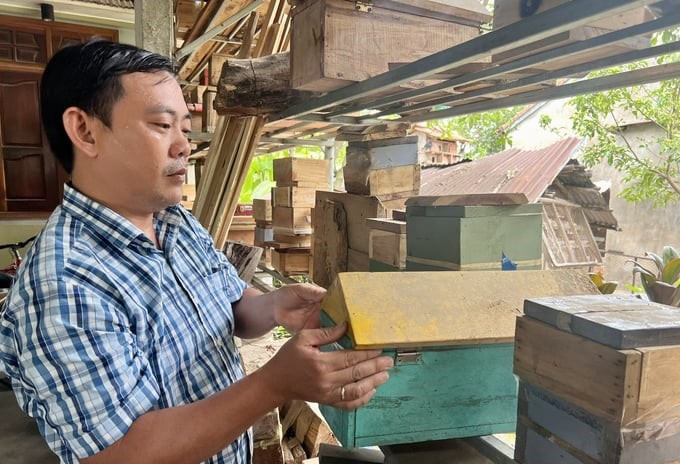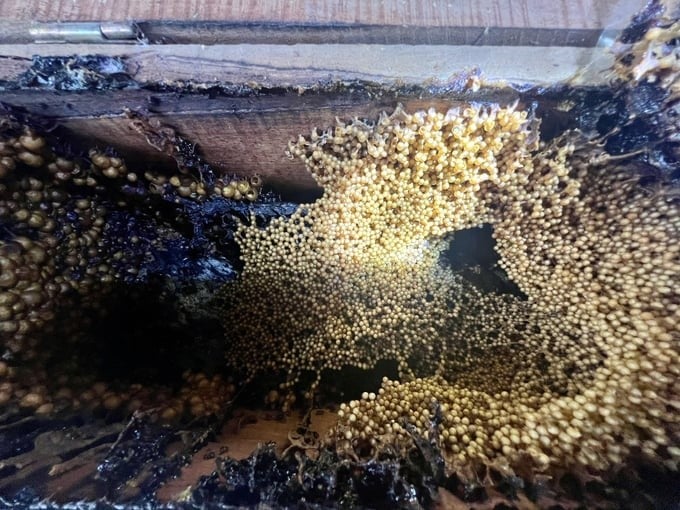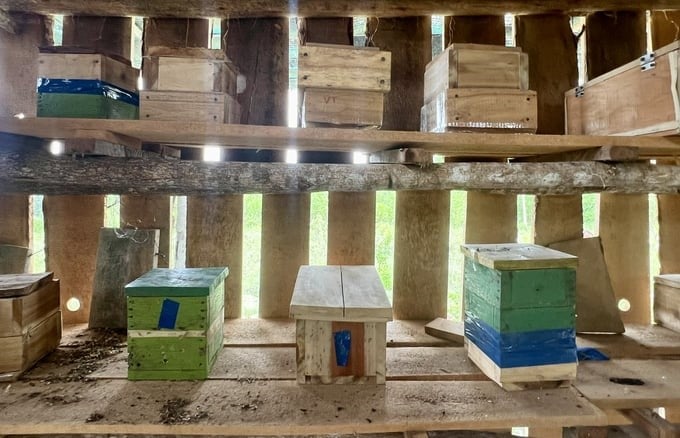November 25, 2025 | 01:45 GMT +7
November 25, 2025 | 01:45 GMT +7
Hotline: 0913.378.918
November 25, 2025 | 01:45 GMT +7
Hotline: 0913.378.918

Mr. Nguyen Van Khuong showed the stingless bee-raising boxes. Photo: KS.
Mr. Nguyen Van Khuong said that he started raising stingless bees (scientific name: Meliponini) in 2019. That was the time he happened to go to the house of a lumberjack from the same hometown and was invited to drink Stingless Bee wine. Hearing the strange name of the bee, he was curious to learn more and found out that stingless bee honey was valuable as a medicinal herb, not simply like honey from other bee species.
Seeing this, he started asking for seeds to try raising and found that this bee species is gentle, does not sting people, and does not require much care. From there, he decided to go to the forests in the province, even to Gia Lai province, to find giant stingless bee hives to bring home to raise colonies.
According to Mr. Khuong, stingless bees often build hives in dry, rotten trees in the forest. When he finds a stingless bee hive, he catches the queen bee and puts it in a box, and then the worker bees see that and follow into the hive. Queen bees have a life cycle of about 3–4 years, while worker bees last 60–70 days, but bee colonies continuously reproduce and store honey.

Mr. Khuong said that for each box he raises in nearly a year, he harvests about 250–500 ml of honey. Photo: KS.
"Stingless bees grow and make honey on their own. They do not eat sugar but only suck the pistils of flowers, so the honey is natural and pure. Stingless bee honey has three flavors: sweet, sour, and bitter. Among them, bitter honey has more value and is sold at a higher price than the other two types," shared Mr. Khuong.
Currently, in addition to his indoor stingless bee farm, Mr. Khuong also has three farms located on the edge of the forest with a total of over 400 hives. For each box he raises in nearly a year, he harvests about 250–500 ml of honey. However, the family has only been harvesting honey for 2 years, averaging nearly 100 liters of honey/year. With a selling price of about VND 1.5 million/liter, after deducting expenses, he earned about VND 100 million.
In addition to raising stingless bees, he also creates colonies, separates colonies, and sells boxes of seeds. Currently, he sells each box of seeds at a price of VND 1.2–1.5 million/box, so he earns an annual income of VND 40–50 million.
After nearly 4 years of raising stingless bees, Mr. Nguyen Van Khuong's honey product was granted a Certificate of Organic Agriculture by the Center for Agro-Forestry-Fisheries Quality Region 2 (Department of Quality, Processing, and Market Development) in 2023. At the same time, he also registered to carry out traceability procedures, bottle finished products, and make product labels with the name "An Nhien Stingless Bee" to promote to consumers.

Currently, Mr. Khuong has 400 stingless bee farming hives. Photo: KS.
With the successes achieved from the stingless bee colony, in early 2024, he continued to register to participate in the local OCOP program. He is now completing the documents to be considered for 3-star OCOP recognition.
Mr. Nguyen Duc Thi, Chairman of the Xuan Quang 2 Commune People's Committee, said that Mr. Nguyen Van Khuong's model of raising stingless bees is a new direction that opens up economic development potential for farmers. For a long time, the majority of people in the commune have mainly developed models of growing cassava, sugarcane, raising cows, and planting forests, but there are not many other agricultural models. Therefore, the local government hopes that the model of raising stingless bees will be replicated, contributing to increasing people's income.
According to the Phu Yen Department of Industry and Trade, the stingless bee honey product is favored by people, so the Department will create conditions to promote the product through display activities at trade and industrial fairs so that the product can reach a large number of consumers.
Stingless bee (Meliponini) also has a queen bee like other bee species, the special thing is that this species of bee does not leave like Micrapis or Apis Dorsata. When there are many "workers" in the colony, they separate into other swarm and so the number of hives is multiplied.
Translated by Thu Huyen

(VAN) The information was shared at the seminar 'Urban Agriculture - Solutions for Developing Green Spaces,' organized by the Kinh te & Do thi Newspaper and the Biotechnology Center of Ho Chi Minh City.
/2025/11/19/4141-2-132831_216.jpg)
(VAN) One of Japfa's outstanding solutions is implementing digital transformation and artificial intelligence (AI) to optimize operations, enhance productivity, and advance sustainable development.
/2025/11/19/4847-1-093540_448.jpg)
(VAN) The Gia Lai Provincial People’s Committee had a working session with the delegation of the U.S. Department of Agriculture, the State of Idaho, and representatives of the State's leading enterprises.

(VAN) Ca Mau has a sufficient foundation to become a strong regional aquaculture center, where production integrates the economy, the environment, and the lives of the people.

(VAN) SEIKI Group envisions itself as a pioneer in the ‘dual transformation’ of digital technology and green industry, standing alongside the Government and Vietnamese businesses in their pursuit of sustainable development.

(VAN) The VNGEONET network affirms Viet Nam's progress in mastering digital space, providing a precise positioning data platform to serve socioeconomic development.
/2025/11/14/3247-1-184556_35.jpg)
(VAN) Thai Nguyen is methodically implementing digital transformation in the livestock sector, laying the foundation for a modern, transparent, and sustainable agriculture.